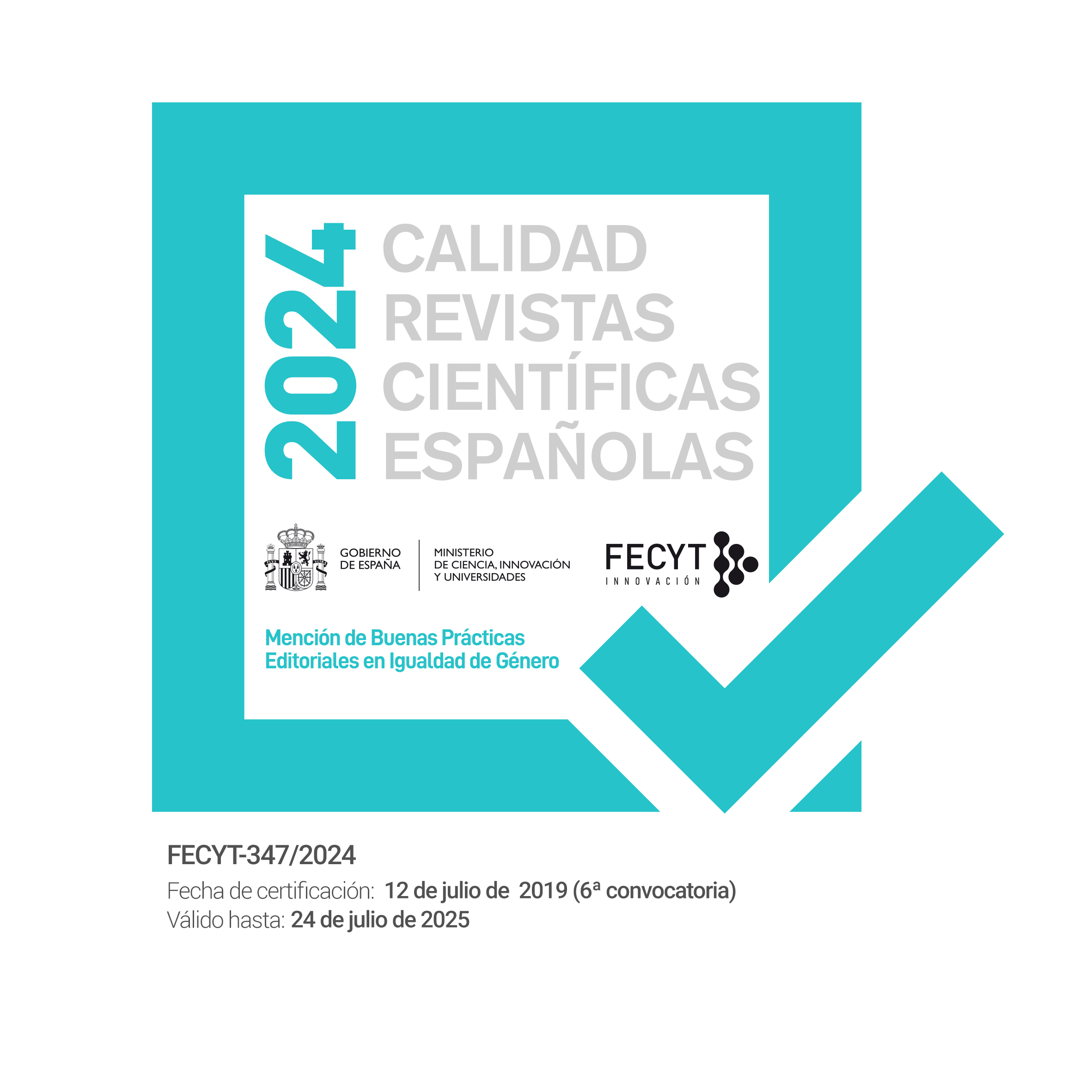A través de los ojos de Dios: La sacralidad de los mares en la visión cartográfica islámica.
DOI:
https://doi.org/10.5944/etfvii.5.2017.18131Palabras clave:
Cartografía islámica, Historia de la cartografía, Manuscrito iluminado, Océano circundante, Mediterráneo, Océano Índico, Golfo Pérsico, Reliquias Sagradas del Profeta Muhammad, Islamic cartography, History of Cartography, Illuminated manuscript, Encircling Ocean, Mediterranean, Indian Ocean, Persian Gulf, Sacred Relics of Prophet MuhammadResumen
Atendiendo a la temática de esta publicación, este artículo indaga sobre la incorporación de lo sagrado en la representación de los mares en la tradición cartográfica islámica medieval KMMS. Por medio de un minucioso análisis de dichas imágenes, este estudio analiza la dimensión sagrada de los cinco mares que encontramos en la representación clásica del mundo de la tradición KMMS desde la perspectiva de lo sagrado en la forma cartográfica: Baḥr al-Muḥīṭ (el Océano Circundante, el golfo pérsico-mar Rojo y océano Indio (Baḥr Fāris), el Mediterráneo (Baḥr al-Rūm), el mar Caspio (Baḥr al-Khazar) y el mar de Aral (Buḥayrat Khwārizm).
Abstract
In keeping with the theme of this issue, this article focuses on the sacrality embedded in the depiction of the seas in the medieval Islamic KMMS mapping tradition. Teasing apart the depictions, this article analyses the sacred dimensions of the fives seas that make up the classical KMMS image of the world: Baḥr al-Muḥīṭ (the Encircling Ocean), the Baḥr Fāris (Persian Gulf-Indian Ocean-Red Sea), Baḥr al-Rūm (the Mediterranean), Baḥr al-Khazar (Caspian Sea),and Buḥayrat Khwārizm (Aral Sea).
Descargas
Citas
Primary:
Al-IṢṬAKHRĪ: Kitāb al-masālik wa-al-mamālik, ed. by al-ḤĪNĪ, Muḥammad Jābir ʿAbd al-ʾĀl. Cairo, Wazārat al-Thaqāfa, 1961.
Al-MUQADDASĪ: Aḥsan at-taqāsīm fī ma’rifat al-aqālīm, transl. by COLLINS, Basil Anthony: The Best Divisions for Knowledge of the Earth. London, Centre for Muslim Contribution to Civilization and Garnet Publishing, 1994.
IBN ḤAWQAL: Configuration de la terre (Kitāb ṣūrat al- arḍ), transl. by KRAMERS, J. H. and WIET, G. 2 vols. Beirut: Commission internationale pour la traduction des chefs-d’œuvre; Paris, Éditions G.- P. Maisonneuve & Larose, 1964.
The Qurʾan, transl. with an introduction by KHALIDI, Tarif. London, Penguin, 2008.
Secondary:
ABDULFATTAH, Iman R.: “Relics of the Prophet and Practices of His Veneration in Medieval Cairo”, Journal of Islamic Archaeology, 1, 1 (2014), 75–105.
AKSOY, Şule and MILSTEIN, Rachel: “A Collection of Thirteenth-Century Illustrated Hajj Certificates”, in SCHICK, Irvin Cemil and DERMAN, Uǧur (eds.): 65 Yaş Armaǧanı. Istanbul, Sabanci Üniversitesi, 2000, 101– 34.
AYDIN, Hilmi: The Sacred Trusts: Pavilion of the Sacred Relics, Topkapi Palace Museum, Istanbul. Clifton, NJ, Tughra Books, 2009.
BARTHOLD, W.: Nachrichten über den Aral-See und den unteren Lauf des Amu-darja von den ältesten Zeiten bis zum XVII. Jahrhundert. Leipzig, Otto Wigand m.b.h., 1910.
BULLIET, Richard W.: The Case of Islamo-Christian Civilization. New York, Columbia University Press, 2004.
DUCÈNE, Jean-Charles: “The Knowledge of the Seas According to the Ottoman Translations and Adaptation of Arabic Works (15th–16th c.)”, in Uluslararası Piri Reis ve Türk Denizcilik Tarihi Sempozyumu, 26–29 Eylül 2013, İstanbul, vol. 4. Ankara, Türk Tarıh Kurumu, 2014, 123–134 and 301–304.
DUCÈNE, Jean-Charles: “Les îles de l’océan Indien dans les sources arabes médiévales: lente découverte ou imagination galopante?” in CANNUYER, Christian (ed.): L’íle, regards orientaux: varia orientalia, biblica et Antiqua, Lille, Société belge d’études orientales, 2013, 125–134.
DUCÈNE, Jean-Charles: “The Ports of the Western coast of India according to Arabic geographers (Eighth-Fifteenth centuries AD): A glimpse into the geography”, in BOUSSAC, Marie-Françoise, SALLES, Jean-François and YON, Jean-Baptiste (eds.): Ports of the Ancient Indian Ocean. Delhi, Primus Books, 2016, 165–178.
DUCÈNE, Jean-Charles: “The Cartography of the Caspian Sea in the Islamic Cartography (17th c.)”, Communication given to the Second II International Congress of Eurasian Maritime History, Saint Petersburg, 23–26 July 2014 (unpublished) <https://www.academia.edu/8055620/The_cartography_of_the_Caspian_Sea_in_the_Islamic_Cartography_17th_c._>.
ELIAS, Jamal: “Islam and the Devotional Image in Pakistan”, in METCALF, Barbara, (ed.): Islam in South Asia in Practice. Princeton, Princeton University Press, 2009, 120–132.
FLOOD, Finbarr Barry: “Bodies and Becoming: Mimesis, Mediation, and the Ingestion of the Sacred in Christianity and Islam”, in PROMEY, Sally M. (ed.): Sensational Religion: Sensory Cultures in Material Practice. New Haven, Yale University Press, 2014, 459–493.
GRUBER, Christiane: “A Pious Cure-All: The Ottoman Illustrated Prayer Manual in the Lilly Library”, in GRUBER, Christiane (ed.): The Islamic Manuscript Tradition: Ten Centuries of Book Arts in Indiana University Collections. Bloomington, Indiana University Press, 2010, 117–153.
GRUBER, Christiane: “The Prophet Muhammad’s Footprint”, in HILLENBRAND, Robert, PEACOCK, A.C.S. and ABDULLAEVA, Firuza (eds.): Ferdowsi, the Mongols and the History of Iran: Art, Literature and Culture from Early Islam to Qajar Persia. London, I. B. Tauris, 2013, 297–307.
KRAMERS, J.H.: “La question Balḫī-Iṣṭaḫrī-Ibn Ḥawḳal et l’Atlas de l’Islam”, Acta Orientalia, 10 (1932), 9–30.
MILLER, Konrad: Mappae arabicae: Arabische Welt- und Länderkarten des 9–13. Jahrhunderts, 6 vols. Stuttgart, 1926–31. Facsimile reprint, 2 vols., ed. by Fuat Sezgin. Frankfurt am Main, Institut für Geschichte der Arabisch-Islamischen Wissenschaften, 1994.
MIQUEL, André: La géographie humaine du monde musulman jusqu’au milieu du 11e siècle, 4 vols. Paris, Mouton, 1967–88.
NAPIER, Gordon: Pocket A–Z of the Knights Templar: A Guide to Their History and Legacy. Stroud, Spellmount, 2014.
PINTO, Karen: “Surat Baḥr al-Rūm (Picture of the Sea of Byzantium): Possible Meanings Underlying the Forms”, in TOLIAS, George and LOUPIS, Dimitris (eds.): Eastern Mediterranean Cartographies: The Cartography of the Mediterranean World. Athens, Institute for Neohellenic Research, 2004, 234–241.
PINTO, Karen: “The Maps Are the Message: Meḥmet II’s Patronage of an ‘Ottoman Cluster’”, Imago Mundi, 63, 2 (2011), 155–179.
PINTO, Karen: Medieval Islamic Maps: An Exploration. Chicago, The University of Chicago Press, 2016.
SHALEM, Avinoam: “Tamīm al-Dārī: A Portrait of Him as the First Muslim Artisan”, Oriente Moderno, 23, 2 (2004), 507–515.
VAGNON, Emmanuelle and VALLET, Éric: La fabrique de l’océan Indien: Cartes d’Orient et d’Occident (Antiquité-XVIe siècle). Paris, Sorbonne, 2017.
WHEELER, Brannon: “Relics in Islam”, Islamica, 11 (2004), 107–112.
WHEELER, Brannon: Mecca and Eden: Ritual, Relics, and Territory in Islam. Chicago, The University of Chicago Press, 2006.
ZADEH, Travis: Mapping Frontiers across Medieval Islam: Geography, Translation, and the ʿAbbasid Empire. New York, I. B. Tauris, 2011.







